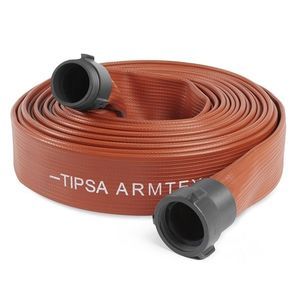
- Company
- Products
- Catalogs
- News & Trends
- Exhibitions
Supply hose ARMTEX JAFRIBrubberPVCflat
Add to favorites
Compare this product
fo_shop_gate_exact_title
Characteristics
- Applications
- supply
- Material
- rubber, PVC
- Other characteristics
- flat
- Diameter
Max.: 152 mm
(5.98 in)Min.: 38 mm
(1.5 in)- Length
15 m, 30 m, 200 m
(49'02" , 98'05" , 656'02" )
Description
Reinforced Extruded Rubber Lay Flat Fire Hose
Formerly ARMTEX 600
-Superior nitrile/PVC rubber hose for use in supply and attack operations
-UL19 & Can/ULC-S511-14 Certified
-Meets or exceeds NFPA 1961 Fire Hose Standard
-Reliable & Robust
Color:
Brick Red and Yellow are the standard colors. Other colors are available upon request.
Aplications:
Specially designed for municipal fire departments, navies, pethrochemical, nuclear plants and other industrial services. Resistant to petroleum, chemicals, and abrasion.
Construction:
Made from circularly woven 100% high tenacity synthetic yarn, completely protected and locked-in by a tough, highly resistant synthetic nitrile rubber & PVC blend, extruded through the weave and forming a single homogenous construction without the use of glues or adhesives.
Lining Properties:
The tensile strength of the lining and cover shall not be less than 1750 p.s.i. (12,000 kpa ), with an ultimate elongation of liner and cover not less than 450%.
Accelerated Aging:
Lining specimens subjected to an exposure of 158ºF ± 3.6ºF, for a duration of 96 hours shall be conditioned as per ASTM D 573, Standard Test Method for Rubber – Deterioration in an Air Oven. Then, the specimens shall be tested to ASTM D4112, Standard Test Methods for Vulcanized Rubber and Thermoplastic Elastomers- Tension, Method A. Upon evaluation, the tensile and elongation properties of the liner shall not be less than 75% of their initial values.
Catalogs
ARMTEX JAFRIB
2 Pages
2023 Product Catalog
93 Pages
Exhibitions
Meet this supplier at the following exhibition(s):

*Prices are pre-tax. They exclude delivery charges and customs duties and do not include additional charges for installation or activation options. Prices are indicative only and may vary by country, with changes to the cost of raw materials and exchange rates.




